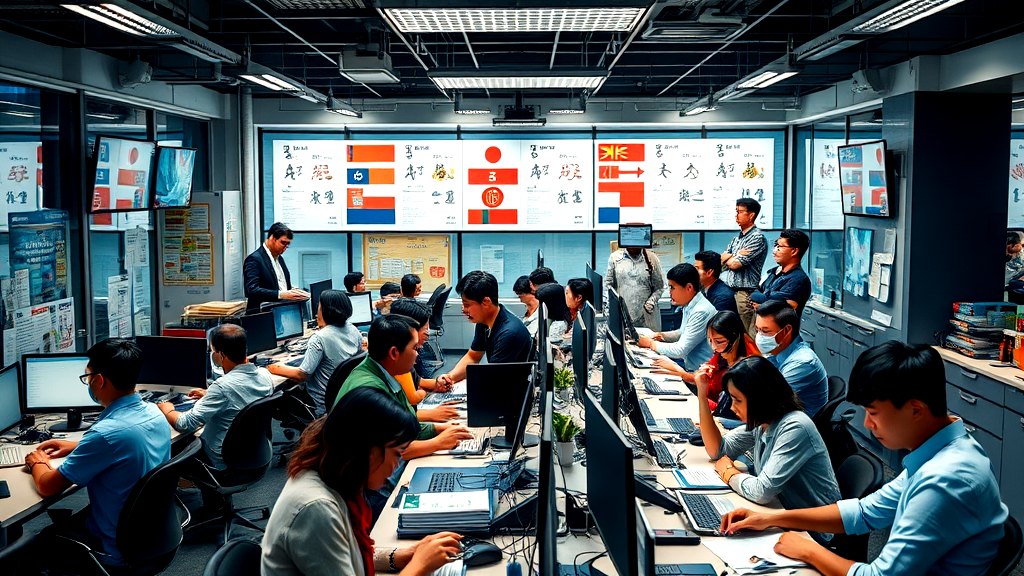Bridging Cultures Through Translation
In the language services industry, bridging cultures is more than just translating words. It’s about connecting people from different backgrounds. I see translators as cultural mediators who ensure messages remain meaningful and engaging. They are skilled at understanding cultural nuances. This is crucial for effective communication.
Human translation offers the depth that machine translation often misses. While machines offer speed, they lack cultural insight. On the other hand, professional translation services provide accuracy and cultural relevance. These services are invaluable for businesses and governments.
Internships in services industry provide budding translators with practical experience. They learn to handle active interpreting and other challenges. Understanding both translation and interpreting is essential in this industry.
Key Takeaways
-
Translators act as cultural mediators, ensuring messages remain meaningful and engaging.
-
Human translation provides depth and cultural insight often missed by machines.
-
Professional translation services are crucial for businesses and governments to maintain accuracy.
-
Effective translation and interpreting require understanding of cultural nuances and language skills.
-
Services industry internships offer hands-on experience with challenges like active interpreting.

Recognizing the Translator’s Role
Highlighting the translator’s essential role involves acknowledging their unique position in global communication. These linguistic maestros go beyond mere word conversion, acting as cultural mediators who bridge divides with precision. Their expertise in the language services industry is pivotal, ensuring translations are not just accurate but resonate with cultural context. This isn’t a walk in the park; it demands a deep understanding of both languages and cultures to deliver content that’s meaningful and engaging.
International translation efforts are the backbone of cross-cultural communication. By enhancing global connections, translators make the world a smaller, more inclusive place. They’re the unsung heroes who foster understanding, bridging cultural gaps with their nuanced skills.
Translators, with their linguistic prowess, play a crucial role in the machine translation realm, where human oversight is still necessary for quality assurance. Their contribution to professional translation services goes beyond technical accuracy, enriching content with cultural depth. As an intern in the services industry, I learned how translators navigate challenges like active interpreting, further highlighting their indispensable role in this field.
|
Translator’s Role |
Skillset Required |
Impact on Communication |
International Efforts |
|---|---|---|---|
|
Cultural Mediator |
Linguistic Proficiency |
Enhances Global Connections |
Bridges Cultural Gaps |
|
Linguistic Maestro |
Cultural Insight |
Fosters Understanding |
Enriches Communication |
|
Language Expert |
Specialized Knowledge |
Ensures Accurate Translations |
Supports Globalization |
|
Role in Machine Translation |
Human Oversight |
Ensures Quality |
Complements Technology |
|
Professional Services |
Industry Knowledge |
Prevents Misunderstandings |
Strengthens Ties |

Skillset Required for Effective Translation
Exploring the necessary skills for impactful translations reveals a multifaceted arena. I’ve found that a profound grasp of both source and target languages is just the beginning. Cultural nuances, oh boy, they matter! It’s like dancing; you must feel the rhythm and flow. Expert translators are like cultural detectives, blending linguistic skills with cultural insight.
The language services industry demands mastery in specialized fields, such as legal or medical jargon. Without this expertise, translations might miss the mark. Being a linguist isn’t just about words; it’s about conveying the essence of a message. It’s a bit like being a chef, mixing the right ingredients to create a delectable dish that suits local tastes.
-
Master both source and target languages.
-
Develop cultural awareness and insight.
-
Gain expertise in specialized fields.
-
Hone excellent linguistic skills.
-
Engage with cultural nuances.
-
Remain adaptable to new trends.
-
Focus on attention to detail.
-
Foster collaboration within the industry.
|
Skillset Aspect |
Importance |
Relevance in International Translation Efforts |
Example Application |
|---|---|---|---|
|
Language Proficiency |
High |
Critical for accurate translations |
Translating legal documents |
|
Cultural Awareness |
High |
Ensures cultural relevance |
Adapting marketing content |
|
Specialized Knowledge |
Medium |
Enhances field-specific accuracy |
Medical translations |
|
Attention to Detail |
Medium |
Prevents errors and misinterpretations |
Proofreading final documents |

Professional Translation Services Explained
Understanding how translation services operate can feel like unlocking a hidden world. These services play a pivotal role in international translation efforts, acting as bridges between languages and cultures. With the rise of the language services industry, these services have become indispensable, especially for businesses aiming to communicate globally.
Professional translators excel in more than just language fluency; they possess cultural awareness and field-specific expertise. For instance, active interpreting is crucial during live events, ensuring immediate and accurate communication. The integration of machine translation into workflows offers speed but lacks the human touch needed for nuanced contexts.
In this realm, choosing the right provider matters. Consider their track record and ability to adapt to your sector’s demands. Services industry internships can offer insights into their operational framework, offering a sneak peek into their processes.
Glossary of Translation Services
|
Aspect |
Importance |
Description |
Application |
|---|---|---|---|
|
Language Services Industry |
High |
Drives globalization efforts |
Business communication |
|
Machine Translation |
Medium |
Provides quick translations |
Initial drafts |
|
Active Interpreting |
High |
Ensures real-time communication |
Conferences and meetings |
|
Professional Translation |
High |
Delivers culturally nuanced translations |
Marketing and legal documents |
|
Translation and Interpreting |
High |
Combines both written and spoken expertise |
Diverse communication needs |

How to Choose a Translation Provider
Choosing a translation provider is like picking the right tool for a job. You need someone who understands your international translation efforts. Look for expertise in your industry. If they translate legal documents, they should know legal jargon. Check their track record. Have they handled big projects before? Their experience can save you headaches later. Don’t forget about their quality assurance process.
You want translations that make sense, not just direct word swaps. And hey, client testimonials are gold. They tell you what others think about them. Can they handle large projects? That’s a biggie if you’ve got tons of content. Lastly, a dash of humor never hurts. If they can make you chuckle, they’re probably fun to collaborate with!
|
Criteria |
Importance |
Impact on Translation |
Ideal For |
|---|---|---|---|
|
Industry Expertise |
High |
Ensures accuracy |
Specialized fields |
|
Track Record |
High |
Builds trust |
Large-scale projects |
|
Quality Assurance |
Medium |
Maintains standards |
Consistent output |
|
Client Testimonials |
Medium |
Offers insights |
Reputation verification |
-
Identify your specific translation needs.
-
Evaluate potential providers’ industry expertise.
-
Review their quality assurance processes.
-
Assess their project management capabilities.
-
Request client testimonials and case studies.

The Concept of Localization in Translation
Localization within translation holds a unique place in international translation efforts. It’s more than just altering text; it’s about integrating cultural contexts into translations. I find it fascinating how localization ensures content resonates with diverse audiences by adapting elements like visuals or even humor. This makes users feel at home, bridging global gaps in a more engaging manner.
In the context of the language services industry, localization is crucial. Ensuring that translated materials are culturally relevant can make or break how information is received. That’s where professional translation services shine, offering expertise to adjust various aspects while maintaining original intent.
Machine translation tools often lack the nuanced touch that localization provides. This is where skilled translators come into play, bringing in cultural insights that machines simply can’t replicate.
In a world where active interpreting and translation are pivotal, localization stands as a testament to the evolving nature of communication. On a similar note, thisamericanlife.org often explores the human experience, highlighting the importance of understanding across cultures.
|
Aspect |
Importance |
Impact |
Example |
|---|---|---|---|
|
Cultural Adaptation |
High |
Enhances user experience |
Visuals, Humor |
|
Machine Translation Limit |
Moderate |
Lacks cultural nuances |
Literal translations |
|
Translator’s Role |
Crucial |
Provides cultural insights |
Cultural references |
|
Professional Services |
Essential |
Ensures accurate localization |
Language adaptations |
|
International Efforts |
Vital |
Bridges cultural gaps |
Global communication |
Cultural Sensitivity in Language Adaptation
Adapting language with cultural awareness is crucial in international translation efforts. I see the importance of understanding cultural norms to ensure the translation resonates. It’s not just about translating words but also about conveying the right tone and context. This becomes especially important when dealing with marketing or media content. Translators must skillfully balance linguistic proficiency and cultural insight to avoid misinterpretations.
Interestingly, the role of machine translation has grown, yet it often misses the mark on cultural nuances. The human touch is still irreplaceable for nuanced translations. In the language services industry, professional translation services are like a safety net, ensuring content stays true to its original intent while adapting to cultural specifics. These services employ experienced translators who understand the subtleties involved.
For instance, active interpreting requires a keen cultural sense to avoid faux pas in real-time conversations. The synergy between translation and interpreting is indeed a linchpin in global communication. The goal remains clear: bridge cultures effectively.
|
Aspect |
Importance |
Challenge |
Key Element |
|---|---|---|---|
|
Cultural Awareness |
High |
Understanding nuances |
Cultural norms# |




